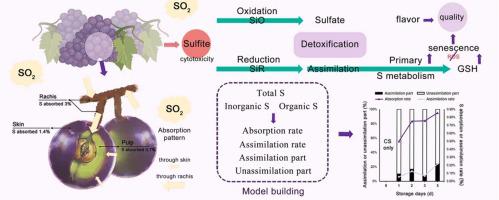Journal of Hazardous Materials ( IF 13.6 ) Pub Date : 2022-07-26 , DOI: 10.1016/j.jhazmat.2022.129685 Yanpei Chen 1 , Zhenbiao Li 1 , Fatima-Ezzahra Ettoumi 1 , Dong Li 1 , Lei Wang 1 , Xiaochen Zhang 1 , Quan Ma 1 , Yanqun Xu 2 , Li Li 1 , Bin Wu 3 , Zisheng Luo 4

|
Sulfur dioxide (SO2) and its derivatives are known to be hazardous but their common application in food, especially the grape industry, is conditionally allowed. Potential hazards to consumers and the environment could occur upon the control-lost SO2 during grape logistics and storage. Researchers have usually focused on the anti-pathogen role of SO2 whereas limited efforts were conducted on the sulfur (S) absorption, assimilation patterns, and sulfite detoxification. In this study, short-term, room-temperature, and SO2-stored grapes were investigated, whose S flux of various forms was quantified through an estimation model. Accordingly, the additional accumulated S (0.50−0.86%) in pulps from atmospheric SO2 was considered mainly through rachis transport compared to across skin surfaces and the usage arrangement of the absorbed S was included. The first quantitative evidence of induced S assimilation under SO2 was also provided, which challenged the previous knowledge. In addition, sulfite oxidase and reductase (SiO and SiR) played major roles in sulfite detoxification, being effectively stimulated at multiple levels. The induced S metabolism associated with enhanced reactive oxygen species (ROS) scavenging capacity and alleviated senescence contributed to quality maintenance. Overall, these findings provide novel insights and are valuable supports for developing SO2-controlling strategies to avoid potential hazards.
中文翻译:

SO2 暴露下鲜食葡萄细胞亚硫酸盐的解毒:硫吸收和同化模式的定量证据
众所周知,二氧化硫 (SO 2 ) 及其衍生物是有害的,但它们在食品中的普遍应用,尤其是在葡萄工业中的应用,是有条件的。在葡萄物流和储存过程中失控的SO 2可能对消费者和环境造成潜在危害。研究人员通常专注于 SO 2的抗病原体作用,而对硫 (S) 吸收、同化模式和亚硫酸盐解毒的研究有限。在这项研究中,研究了短期、室温和 SO 2储存的葡萄,通过估计模型量化了其各种形式的 S 通量。因此,来自大气 SO 2的纸浆中额外积累的 S (0.50-0.86%)与跨皮肤表面相比,主要通过轴运输考虑,并且包括吸收的 S 的使用安排。还提供了在 SO 2下诱导的 S 同化的第一个定量证据,这对先前的知识提出了挑战。此外,亚硫酸盐氧化酶和还原酶(SiO和SiR)在亚硫酸盐解毒中起主要作用,在多个层面上得到有效刺激。诱导的 S 代谢与增强的活性氧 (ROS) 清除能力和减轻的衰老相关,有助于维持质量。总体而言,这些发现提供了新颖的见解,并为制定 SO 2控制策略以避免潜在危害提供了宝贵的支持。

























 京公网安备 11010802027423号
京公网安备 11010802027423号